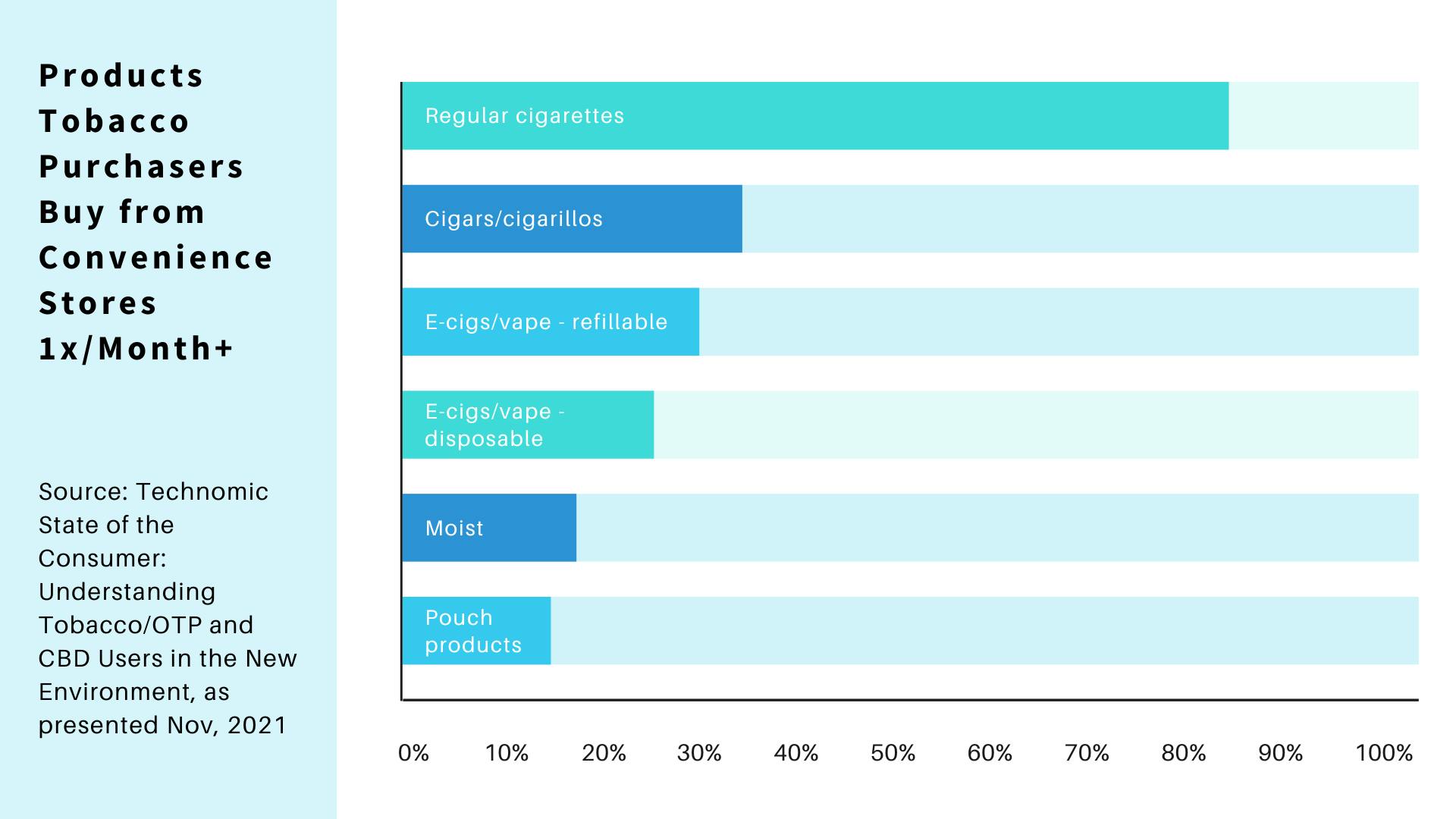It may not have the cachet it once did, but smoking is still popular in the U.S. and the U.K. and is often a driver for consumers to visit a store —especially in the convenience channel. On RangeMe, there are 1,133 tobacco and 1,081 vaping products, but these are dwarfed by the 27,668 CBD, 29,486 hemp, and 8,311 THC product offerings.
According to IRI, a Chicago-based market research firm, sales of cigarettes declined by 3.8% in the four weeks ending May 15, 2022, in all multi-unit retailers. At the same time, sales of electronic smoking devices jumped by 12.8%.
In the U.K., according to the Office for National Statistics’ Opinions and Lifestyle Survey in 2020, 14.5% of people aged 16 years and over reported that they smoked, with 6.4% of respondents (3.3 million adults) using e-cigarettes.
Where’s tobacco sold?
Convenience stores are a top location for tobacco purchases and 29% of consumers shop there for tobacco products, according to a presentation last November: State of the Consumer: Understanding Tobacco/OTP and CBD Users in the New Environment, from Donna Hood Crecca, principal with Technomic.
Convenience stores are also a top location for CBD purchases, with 29% of consumers making purchases there and a quarter of people visiting at least once a day. In fact, 61% of CBD users enter the store every—or nearly every—time they fill up with gas.

But convenience stores aren’t the only place consumers are shopping for CBD. An almost equal number (28%) buy CBD products from online grocery retailers; 27% from specialty grocery stores; 26% from drug stores; 26% from mass merchants; and 22% from traditional grocery stores, according to Technomic.
Tobacco users and CBD users are often the same people. According to Technomic’s presentation, 36% of tobacco purchasers buy CBD products too; and 38% of CBD purchasers also buy tobacco.
A key way to draw consumers into a CBD section, says Hood-Crecca, is by having a dedicated section for it, which appeals to 64% of consumers. This, she says, “raises the visibility of CBD availability and can increase consumer trust, establishing and communicating product quality standards.”
Other retailers
While cigarettes are a mainstay for convenience stores, they’re much less so for other retailers. In fact, in March of 2022, Walmart announced it would stop selling cigarettes in some stores in Arkansas, California, Florida, and New Mexico.
The move is said to bring Walmart more in line with the growing array of health and wellness products it offers, but the retailer is a little slow off the mark. Other retailers abandoned tobacco sales years ago — Target as early as 1996 and CVS Health in 2014.
A change to the law in the U.K. in 2012 dictated that all retailers must keep cigarettes out of sight except when staff are serving customers or are restocking. The goal was to give less access to cigarettes, especially for youth.
Vaping distinctions
While cigarettes may be the preferred method of ingestion for adults, e-cigarettes are most common among younger generations.
In the 2021 National Youth Tobacco Survey, the Centers for Disease Control and Prevention asked middle and high school students about their tobacco use. Most commonly used are e-cigarettes, reported by 7.6% of students, followed by cigarettes (1.5%). In total, just over 2 million middle and high schoolers use e-cigarettes daily.
However, things are different in the U.K. When e-cigarettes were first launched stateside, they were embraced as a better offering than cigarettes. In the U.K., meanwhile, they were viewed as a pathway to quit smoking cigarettes.
One company that’s created a lot of controversies is Juul, which launched vaping products in 2015. The company apparently marketed to consumers in their 20s, 30s, and even younger, and is said to have bought advertisements on teen-focused websites for Nickelodeon, Cartoon Network, and Seventeen magazine.
In June of 2022, the FDA ruled that Juul can no longer sell any of its products in the U.S. In Europe, Juul products are no longer available in Austria, Belgium, Portugal, France, and Spain.
Hemp health
Hemp CBD is slightly different from cannabis CBD. Hemp and cannabis (marijuana) are both plants, and part of the same family, but the cannabis plant has high levels of THC, which gives users a “high;” while hemp’s levels are very low.
Hemp oil is a great source of polyunsaturated fatty acids, which is good for heart health, blood pressure, and inflammation, among other things. Hemp seeds, meanwhile, contain those same fatty acids along with other beneficial nutrients like magnesium, iron, and Vitamin E.
While tobacco use might be waning, these other products, especially CBD, are becoming more popular. Wise retailers will add them to their shelves.
Are you a buyer on RangeMe? Browse healthier cigarettes/tobacco alternatives like hemp and CBD here.

